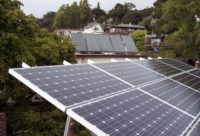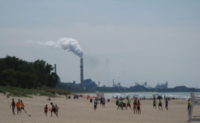Northeastern coastal states are moving quickly to add more renewable energy, including offshore wind and hydroelectric power, even as the Trump administration champions traditional sources and coastal oil drilling in the area. But the push is not universal in the region.
New England utility Eversource will appeal a decision by New Hampshire officials to reject the construction permit for a $1.6-billion transmission project that would send clean hydroelectric power from Canada to the New England power grid.
The rejection, based on impacts to the state's environment and economy, came just a week after Massachusetts selected the project on Jan. 25 from more than 40 proposals in response to an RFP for new sources of clean energy to meet its clean-energy goal, enacted in 2016. It is set to transport 1,090 MW of renewable energy to the grid 192 miles, from the Canadian border to southern New Hampshire, where it will connect with the power grid serving that state, Massachusetts, Connecticut, Vermont and Rhode Island.
“Eversource is committed to the project,” Martin Murphy, a company spokesman said, noting that the state site evaluation committee did not evaluate two of the four criteria for selection. “In our minds the application was not fully evaluated. It is essential to seek rehearing. It holds great promise for benefits in New England and New Hampshire,” he said.
Massachusetts has not commented on the rejection.
Units of Quanta Services are set to design and build the project, along with ABB. Burns & McDonnell has worked on the project since its early stages and will continue, Eversource said. The project is set to come on line in 2020.
Within a month, Montreal utility Hydro-Québec plans to solicit engineers and contractors to design and build its 50-mile, 320-kV transmission line, which will connect to the U.S. portion of the project, says Nicholas Tremblay, project manager. The $550-million project includes overhead and underground lines and an AC-to-DC converter station.
Wind Blows
In New York, Gov. Andrew Cuomo (D) on Jan. 29 released what he said was the nation’s first offshore-wind master plan. It will guide development of 2,400 MW of offshore wind by 2030, considered key in reducing greenhouse-gas emissions and reaching 50% renewable energy by 2030. In his state-of-the-state address, Cuomo called for the procurement of at least 800 MW of offshore wind in two solicitations to be issued this year and next. Cuomo also directed the investment of $15 million to train workers for offshore-wind design, construction, installation, operations and maintenance.
“While the federal government continues to turn its back on protecting natural resources and plots to open up our coastline to drilling, New York is doubling down on our commitment to renewable energy and the industries of tomorrow,” Cuomo said, predicting the creation of about 5,000 jobs.
Three bidders in late December also responded to Massachusetts’ solicitation for long-term contracts for 400 MW of offshore wind, the first of a staggered procurement for 1,600 MW by June 2027. Companies could bid up to 800 MW.
Deepwater Wind—developer of the 30-MW Block Island offshore wind farm, the nation’s first to operate—proposed coupling incremental offshore wind with grid-scale pumped storage. The proposed amount of wind power was not disclosed, but the incremental approach is meant to take advantage of falling offshore-wind costs, the company said.
Bay State Wind, which includes a U.S. unit of Denmark’s Ørested A/S, and Vineyard Wind, owned by Copenhagen Infrastructure Partners, each submitted bids for 400 MW and 800 MW. Selection of a bidder to begin contract negotiations is set for April 23. Massachusetts, Connecticut and Rhode Island are negotiating with six companies to provide the three states with 460 MW of clean energy. Set to be completed by Jan. 15, contract negotiations have been delayed.
Momentum
New Jersey is moving quickly under newly elected Gov. Phil Murphy (D) to return to its 2010 goal of installing 1,100 MW of offshore wind, a plan blocked by former Gov. Chris Christie (R), notes Jeff Tittel, director of the state Sierra Club and a member of Murphy’s transition team. “This is our first real step forward in seven years,” he tells ENR, adding that agenda items for Murphy’s first 100 days include issuing an RFP for offshore wind and expanding the goal to 3,500 MW over the next year.
The federal Bureau of Ocean Energy Management (BOEM) issued commercial leases off New Jersey’s coast in 2016 to U.S. Wind, owned by Italian construction giant Toto Holdings, and to Ocean Wind, owned by Ørested. “The state has the power under existing rules to go ahead with construction,” Tittel says.
The bureau, part of the U.S. Interior Dept., last month issued draft guidelines for the “design envelope” approach in offshore-wind project construction and operations. The guidelines would allow developers to make certain design decisions later in the process to take advantage of new technology, said BOEM. Further, it would allow the agency to analyze project environmental impacts that could cut or eliminate other reviews, according to BOEM.
But Maine Gov. Paul LePage (R) on Jan. 25 issued a moratorium on new offshore and land-based wind projects, claiming in a statement that “current law is too ambitious and overly permissive in areas of the state where we must protect our scenic vistas.” The edict is in effect while a nonpublic task force studies impacts and recommends regulatory changes related to project development.






Post a comment to this article
Report Abusive Comment